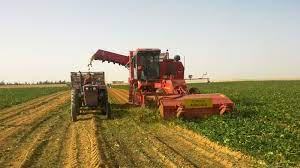What are the types of harvesting equipment? If your farm is over a certain size or if you grow a particular type of crop, investing in a combine may be one of the most beneficial additions you can make to your collection of machines. But what are the various kinds of combine harvesters that are available?
There Are Numerous Varieties Of Combine Harvesters
Combine harvesters generally fall into one of two categories, which are as follows:

- CONTROL COMBINE HARVESTER
There is another name for this kind of combine harvester, and that is a tractor pull combine. You could also hear it referred to as a tractor combine or a pull-type harvesting combine. Both of these names are accurate. These names give the impression that the combination in question does not advance under its own power.
Instead, it is pulled by the tractor and the operations of the tractor:
- Threshing
- Cutting
- Separating
- Cleaning
This apparatus is driven by the takeoff shaft of the tractor. Despite the fact that it is a less common type of combine, there is still a market for it in certain farming contexts.
There is also a type of control combine harvester that is pushed by a tractor and has a variety of engines that are used to power its many functions. Despite this, farmers don’t rely on these kinds as much as they could.
- SELF-PROPELLED HARVESTER
This particular model of combine harvester is the most common one found on modern farms due of its widespread popularity. This particular type of combine generates its own power via an engine that is attached to the device. The engine has two purposes: it provides power to the machine itself, as well as power to all of the activities that are associated with harvesting. There are two distinct types of combine harvesters that are self-propelled:
The threshing mechanism and the straw walkers are the two primary components of the traditional combine harvester.
The axial flow threshing system is the primary component of an axial flow combine harvester or a rotary combine harvester. This model of self-propelled combine harvester is by far the most common and widely used variety.
What Are the Different Components That Make Up a Combine Harvester?
These components are standard across the board for combine harvesters and can be found on any model:
The engine, the fuel tank, the wheels, the ground power train, and the steering mechanism are all components of the chassis.
The grain is collected by the combine header, which is mounted to the front of the combine and moves forward.
The job of removing grain from the surrounding vegetation is done by the threshing unit.
The grain is separated from the chaff, which may include bits of vegetation, dirt, insects, or anything else that you do not want mixed in with your grain by using straw walkers.
The grain that has been cleaned is transferred into the grain storage tank by the cleaning system, while the chaff is expelled from the back of the machine.
The combine must, of course, be equipped with a seat for the operator so that they may work comfortably. So, this is the taxicab in which you will find the following:
- Seat
- Taking Charge of the Wheel
- Instrumentation
- Console for Controlling the Process
- Controlling the Climate System


Recent Comments